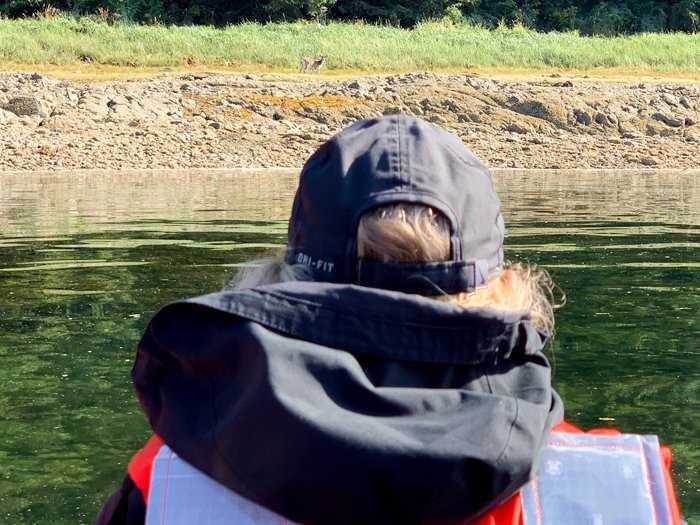In the cool morning air of early autumn, deep in the thick dark of Southeast Alaskan forest, we landed on the rocky shores of Sitkoh Bay for the final day of our expedition. In the distance, in a green meadow, was a coastal brown bear lurking, scouring for salmon spawning in Sitkoh River. On a nearby shoreline, a Sitka black-tailed deer grazed on sedges just above the intertidal zone. A mink scurried from the rocky beach back to the safety of its forest den with a delicious sea urchin snack clutched in its forepaws. Bald eagles, ravens, and gulls alike waited patiently for the salmon of Sikoh River to reach the end of their lifecycle and wash up on the sandy shore. Aggregations of moon jellies caught up in the water currents search for anything that may drift into their stinging tentacles.
Today, we saw plenty of evidence of the new moon phase we are in with the -4-foot tides as we landed for our morning of hiking and kayaking. With the moon and sun on opposite sides of the earth, the pull of Earth’s gravity is nothing compared to the opposing forces of the other celestial bodies, creating 20+ foot tidal ranges in the Southeast Alaska region. Guests treaded lightly up to the trailhead, avoiding echinoderms with every step.
Many creatures are well-adapted for the extreme and ephemeral environment of the intertidal zone. Those found higher in on the shoreline – such as small barnacles and mussels – are able to seal their shells to store seawater and thus avoid desiccation until the next high tide. Closer to the waves, we find animals with incredible strength to fight the wave action in their environment: sea stars with their water-vascular system of tube feet, chitons with a muscular foot to cement their hold on rocks, blue mussels with byssal threads made of a protein so strong that scientists are looking into their chemical components to create materials for human use. Lower still, in that region signified by the negative tide, we begin to see animals that are less accustomed to exposure but are still able to withstand small periods of time out of their comfort zone.
After a morning of exploration (and a Global Explorers’ Zodiac lesson, to boot), some brave guests plunged into the balmy waters of Alaska in order to have just a few wet items to pack in their suitcase later that afternoon. A week of unforgettable people, places, and wildlife…We head to Sitka for debarkation in the morning.







